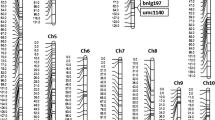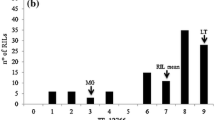Abstract
The basic prerequisite for an efficient breeding program to improve levels of resistance to pathogens in plants is the identification of genes controlling the resistance character. If the response to pathogens is under the control of a multilocus system, the utilization of molecular markers becomes essential. Stalk and ear rot caused by Gibberella zeae is a widespread disease of corn: resistance to G. zeae is quantitatively inherited. Our experimental approach to understanding the genetic basis of resistance to Gibberella is to estimate the genetic linkage between available molecular markers and the character, measured as the amount of diseased tissue 40 days after inoculation of a suspension of Fusarium graminearum, the conidial form of G. zeae, into the first stalk internode. Sensitive and resistant parental inbreds were crossed to obtain F1 and F2 populations: the analysis of the segregation of 95 RFLP (restriction fragment length polymorphism) clones and 10 RAPD (random amplified polymorphic DNA) markers was performed on a population of 150 F2 individuals. Analysis of resistance was performed on the F3 families obtained by selfing the F2 plants. Quantitative trait loci (QTL) detection was based either on analysis of regression coefficients between family mean value and allele values in the F2 population, or by means of interval mapping, using MAPMAKER-QTL. A linkage map of maize was obtained, in which four to five genomic regions are shown to carry factors involved in the resistance to G. zeae.
Similar content being viewed by others
References
Beavis WD, Grant D (1991) A linkage map based on information from four F2 populations of maize (Zea mays L.). Theor Appl Genet 82:636–644
Beavis WD, Grant D, Albertsen M, Fincher R (1991) Quantitative trait loci for plant height in four maize population and their associations with qualitative genetic loci. Theor Appl Genet 83:141–145
Beckmann JS, Soller M (1983) Restriction fragment length polymorphisms in genetic improvement: methodologies mapping, and costs. Theor Appl Genet 67:35–43
Binelli G, Gianfranceschi L, Pè ME, Taramino G, Busso C, Stenhouse J, Ottaviano E (1992a) Similarity of maize and sorghum genomes as revealed by maize RFLP probes. Theor Appl Genet 84:10–16
Binelli G, Gianfranceschi L, Angelini P, Camussi A, Pè ME (1992b) Multivariate analysis for the evaluation of stalk-rot resistance in twenty-seven maize inbreds. Maydica 37:339–342
Burr B, Burr FA (1991) Recombinant inbreds for molecular mapping in maize: theoretical and practical considerations. Trends Genet 7:55–60
Burr B, Evola SV, Burr FA, Beckmann JS (1983) The application of restriction fragment length polymorphisms to plant breeding. In: Setlow JK, Hollander A (eds) Genetic engineering: principles and methods, vol 5. Plenum, New York, pp 45–49
Cappellini RA, Peterson JL (1965) Macroconidium formation in submerged cultures by a non-sporulating strain of Gibberella zeae. Mycologia 57:962–966
Dellaporta SL, Wood J, Hicks JB (1985) Molecular biology of plants. Cold Spring Harbor Laboratory Press, Cold Spring Harbor, NY, pp 36–37
Edwards MD, Helentjaris T, Wright S, Stuber CW (1992) Molecular-marker facilitated investigations of quantitative trait loci in maize. Theor Appl Genet 83:765–774
Helentjaris T, Slocum M, Wright S, Schaefer A, Nienhuis J (1986) Construction of genetic linkage maps in maize and tomato using restriction fragment length polymorphism. Theor Appl Genet 72:761–769
Helentjaris T, Weber D, Wright S (1988) Identification of the genomic locations of duplicate nucleotide sequences in maize by analysis of restriction fragment length polymorphism. Genetics 118:353–363
Hulbert SH, Richter TE, Axtell JD, Bennetzen JL (1990) Genetic mapping and characterization of sorghum and related crops by means of maize DNA probes. Proc Natl Acad Sci USA 87:4251–4255
Klessig DF, Berry JO (1983) Improved filter hybridization method for detection of single copy sequences in large eukaryotic genomes. Plant Mol Biol Rep 1:12–18
Lander ES, Botstein D (1989) Mapping mendelian factors underlying quantitative traits using RFLP linkage maps. Genetics 121:185–199
Lander ES, Green P, Abrahamson J, Barlow A, Daly MJ, Lincoln SE, Newburg L (1987) MAPMAKER: an interactive computer package for constructing primary linkage maps of experimental and natural populations. Genomics 1:174–181
McCouch SR, Kochert G, Yu ZH, Wang ZY, Khush GS, Coffman WR, Tanksley SD (1988) Molecular mapping of rice chromosomes. Theor Appl Genet 76:815–829
Mostafa MAN, Coors JG, Drolsom PN (1988) Selection for resistance to stalk rot in maize caused by Gibberella zeae (Schw.) Petch. Maydica 23:15–26
Paterson AH, Lander ES, Hewitt JD, Peterson S, Lincoln SE, Tanksley SD (1988) Resolution of quantitative traits into Mendelian factors by using a complete linkage map of restriction fragment length polymorphisms. Nature 335:721–726
Pè ME, Greco R, Taramino G, Gianfranceschi L, Tarchini R, Binelli G (1993) A novel RFLP linkage map from an F2. Maize Genetics Cooperation Newsletter 67:79–81
Sari-Gorla M, Pè ME, Mulcahy DL, Ottaviano E (1992) Genetic dissection of pollen competitive ability in maize. Heredity 69:423–430
Weller JI, Seller M, Brody T (1988) Linkage analysis of quantitative trait in an interspecific cross of tomato (Lycopersicon esculentum x Lycopersicon pimpinellifolium) by means of genetic markers. Genetics 118:329–339
Whitkus R, Doebley J, Lee M (1992) Comparative genome mapping of sorghum and maize. Genetics 132:1119–1130
Williams JGK, Kubelik AR, Livak KJ, Rafalski JA, Tingey SV (1990) DNA polymorphisms amplified by arbitrary primers are useful as genetic markers. Nucleic Acids Res 18:6531–6535
Author information
Authors and Affiliations
Additional information
Communicated by R. Hagemann
Rights and permissions
About this article
Cite this article
Enrico Pè, M., Gianfranceschi, L., Taramino, G. et al. Mapping quantitative trait loci (QTLs) for resistance to Gibberella zeae infection in maize. Molec. Gen. Genet. 241, 11–16 (1993). https://doi.org/10.1007/BF00280195
Received:
Accepted:
Issue Date:
DOI: https://doi.org/10.1007/BF00280195




